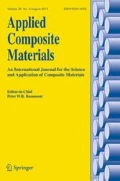Abstract
A detailed investigation of the deformation mechanisms in tile-reinforced armored components was conducted to develop the most efficient modeling strategies for the structural analysis of large components of the Composite Armored Vehicle. The limitations of conventional finite elements with respect to the analysis of tile-reinforced structures were examined, and two complementary optimal modeling strategies were developed. These strategies are element layering and the use of a tile-adhesive superelement. Element layering is a technique that uses stacks of shear deformable shell elements to obtain the proper transverse shear distributions through the thickness of the laminate. The tile-adhesive superelement consists of a statically condensed substructure model designed to take advantage of periodicity in tile placement patterns to eliminate numerical redundancies in the analysis. Both approaches can be used simultaneously to create unusually efficient models that accurately predict the global response by incorporating the correct local deformation mechanisms.
Similar content being viewed by others
References
Dávila, C. G., Smith, C., and Lumban-Tobing, F., 'Analysis of Thick Sandwich Shells with Embedded Ceramic Tiles', Proc. 11th DoD/NASA/FAA Conference on Fibrous Composites in Structural Design 1, WL-TR–97–3008, Fort Worth, TX, August 1996.
Whitney, J. M., 'Shear Correction Factors for Orthotropic Laminates Under Static Load', J. Appl. Mech. ASME 40, 1973, 302–304.
Cho, Y.-B. and Averill, R. C., 'An Improved Theory and Finite-Element Model for Laminated Composite and Sandwich Beams Using First-Order Zig-Zag Sublaminate Approximations', Composite Structures 37(3–4), 1997, 281.
Wang, J. T., Raju, I. S., Dávila, C. G., and Sleight, D. W, 'Computation of Strain Energy Release Rates for Skin-Stiffener Debonds Modeled with Plate Elements', Proc. AIAA/ASME/ASCE/AHS 34th Structures, Structural Dynamics, and Materials Conference,April 1993. AIAA Paper 93–1501.
Pike, T., Lumban-Tobing, F., Smith, C., and Garcia, R., 'Composite Armored Vehicle Component Analysis and Test Result Correlation,' Proc. 11th DoD/NASA/FAA Conference on Fibrous Composites in Structural Design 1, WL-TR–97–3008, Fort Worth, TX, 1996.
Anon, ABAQUS Theory Manual, Version 5.5, Hibbit Karlsson & Sorensen, Inc., Pawtucket, RI, 1995, pp. 2.13.1–2.
Anon, ABAQUS User's Manual, Version 5.6, Hibbit Karlsson & Sorensen, Inc. Pawtucket, RI, 1996.
Dávila, C. G., Baker, D. J., and Taylor, S., Superelement Analysis of Tile-Reinforced Composite Armor, Report VTC NR 97–04, Army Research Laboratory, NASA Langley Research Center, Hampton, VA, 1997.
Anon, MSC PATRAN V7.5 User's Manual, McNeal-Schwendler Corp., Los Angeles, CA, 1997.
Dávila, C. G., 'Superelement Analysis of Tile-Reinforced Composite Armor', Proc. 11th Worldwide ABAQUS User's Conference, Newport, RI, 1998.
Dávila, C. G., Chen, Tzi-Kang, and Baker, D. J., 'Analysis of Tile-Reinforced Composite Armor. Part1: Advanced Modeling and Strength Analyses', Proc. 21st Army Science Conference, Norfolk, VA, 1998.
Author information
Authors and Affiliations
Rights and permissions
About this article
Cite this article
Dávila, C.G., Chen, TK. Advanced Modeling Strategies for the Analysis of Tile-Reinforced Composite Armor. Applied Composite Materials 7, 51–68 (2000). https://doi.org/10.1023/A:1008923521077
Issue Date:
DOI: https://doi.org/10.1023/A:1008923521077




